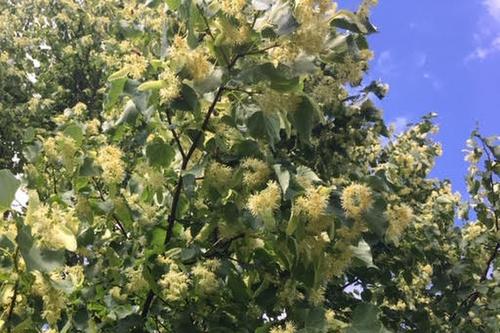
Linden trees — fragrant shade trees found across the Midwest — have long provided bees with vital pollen and nectar. But occasionally, dead bumble bees have been observed beneath flowering linden trees, as well.
In the past, these rare linden-associated bumble bee deaths have been attributed — with limited evidence — to toxicity from sugars in linden flower nectar, or to starvation due to low nectar in late-blooming linden trees. A research team including Sujaya Rao, now a professor at the University of Minnesota, investigated both factors by examining crawling or dead bumble bees near the trees and found a more complicated relationship between linden trees and bee mortality.
In their study, published recently in the journal PLOS One, researchers concluded bee deaths associated with linden trees occur only in specific scenarios: a combination of low ambient temperature and the tendency of bumble bees to return to forage on linden even when nectar is low, as is often the case in late-blooming linden flowers. Foraging on low nectar can result in bees having an energy deficit, which could lead to the bees being unable to maintain the thoracic temperature required for flight. Consequently, they fall to the ground, crawl and, ultimately, die.
Linden-bumble bee mortality has been observed in Minnesota in the Duluth area by Claire Lande, a research associate at Oregon State University and the paper’s lead author.
“Despite this phenomenon, it is not that linden trees are causing bee mortality. It's amazing what great quantities of food resources they provide bees,” Rao said. “It is well documented that bees die from a number of different factors — pesticides, diseases, a lack of floral resources. But even when you have ample floral resources, like in the case of linden trees, a combination of factors can lead to death.”
Researchers tested two hypotheses about the link between linden trees and bee mortality: that linden flowers produce mannose, a sugar that is toxic to bees, and that bees foraging on linden flowers die of starvation because of inadequate nectar production.
The study concluded that:
- linden nectar does not produce mannose, but it does contain a naturally occurring compound called trigonelline that could cause bees to continue foraging on linden flowers despite their low nectar content;
- bumble bee deaths associated with linden trees follow basic bee physiology. Because bees require additional energy to maintain flight when temperatures are below 86 degrees Fahrenheit , if they have an energy deficit from foraging on low-nectar, late-blooming linden flowers, they may fall from flight, crawl and eventually die.
“It is a rare phenomenon for bees to die after foraging on linden. It happens when you have a few factors all lined up. Many bees forage on linden: it's a beautiful tree, and bees tend to keep coming back,” Rao said.
“We have found that, at any given time, not every linden tree causes bee mortality, and that not every bee that forages on a linden tree dies. Linden-associated bee mortality remains a complex phenomenon, not yet adequately explained by the hypotheses of mannose toxicity or low-nectar starvation alone.”
This study was supported by the USDA National Institute of Food and Agriculture.
Sujaya Rao is a professor and head of the Department of Entomology at the U of M’s College of Food, Agricultural and Natural Resource Sciences (CFANS). Her areas of expertise include pest management in agricultural crops, and native bee pollinators in agricultural and native landscapes.
About the College of Food, Agricultural and Natural Resource Sciences
The University of Minnesota College of Food, Agricultural and Natural Resource Sciences (CFANS) offers students and the community unparalleled experiential learning opportunities through its 10 research and outreach centers across Minnesota, the Minnesota Landscape Arboretum and the Bell Museum of Natural History. Among its varied degree programs for undergraduate and graduate students are agricultural education, marketing communications, health and nutrition, and natural resources science and management. Learn more at cfans.umn.edu.
- Categories:
- Agriculture and Environment





